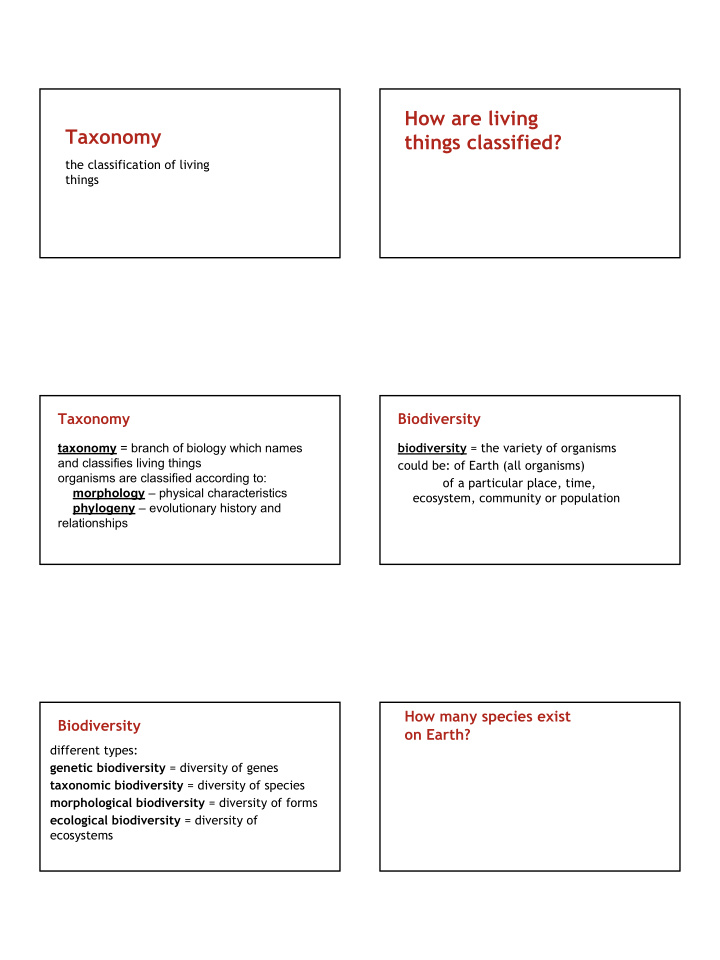



How are living Taxonomy things classified? the classification of living things Taxonomy Biodiversity taxonomy = branch of biology which names biodiversity = the variety of organisms and classifies living things could be: of Earth (all organisms) organisms are classified according to: of a particular place, time, morphology – physical characteristics ecosystem, community or population phylogeny – evolutionary history and relationships How many species exist Biodiversity on Earth? different types: genetic biodiversity = diversity of genes taxonomic biodiversity = diversity of species morphological biodiversity = diversity of forms ecological biodiversity = diversity of ecosystems
there are many studies estimating the total number of species on Earth Biodiversity not all species have been identified or observed, and many studies have attempted to estimate the total number of species on Earth estimates vary but are usually at least 10 million species , sometimes more this table represents the results of one study Why is naming and Naming Organisms classifying necessary? naming is necessary so scientists know exactly what one another are talking about common names vary by region, language common names can be misleading ex. jellyfish ≠ fish What is wrong with this system of classification? an early system of classification
the rules for writing scientific names: Naming Organisms – genus name first, species name second – genus name capitalized, species name not Carl Linnaeus – developed first universal – underlined or italicized naming & classification system for organisms – divided organisms into 3 kingdoms based on examples: lion is Panthera leo , human is Homo shared morphology sapien , a certain species of amoeba is Chaos – developed binomial nomenclature = two chaos part names – Genus species Eight Levels of Classification Modern Taxonomy domain → kingdom → phylum → class → still uses binomial nomenclature and Linnaeus’ order → family → genus → species 7 levels classification based primarily on phylogeny D id K ing P hillip C ome O ver F or G reat S oup? taxonomy changes as more is learned about an organism from more inclusive (includes more organisms) to less inclusive (includes fewer organisms) lion = grizzly bear = eukarya eukarya animalia animalia chordata chordata mammalia mammalia carnivora carnivora felidae ursidae panthera ursus leo arctos
What is a species? ex. dogs and wolves can produce fertile Biological Species Concept offspring = same species (different “sub” species) species = the largest group of organisms capable of interbreeding and producing fertile offspring ● their offspring can produce offspring ● typically share morphology, similar DNA, and way of life wolf dog horses and donkeys can produce mules, but they are infertile = not the same species horse donkey mule liger
3 domains Archaea some of the oldest species Archaea , Bacteria , and Eukarya on Earth Defined by two things: type of cell, molecular differences unique ancient evolutionary history Archaea and Bacteria are prokaryotes (no some archaebacteria live in many are extremophiles - hot springs ex. in Grand nucleus) live in extreme conditions Prismatic Springs - Eukarya are eukaryotes (nucleus) harmful to most organisms Yellowstone Archaea Archaea examples: all are prokaryotic, unicellular methanogens - produce the gas methane can be either autotrophs and heterotrophs halophiles - live in very salty water have cell walls thermoacidophiles - thrive in acidic high temperature water Bacteria What is an example of different RNA from Archaea bacteria? include disease causing bacteria examples: Cyanobacteria photosynthetic; related to chloroplasts of plants and algae
Bacteria Bacteria E coli enterobacteria - Spirochaetes – include those B animalis include E. coli and causing syphilis and Lyme salmonella & bacteria disease that live on other Firmicutes – including salmonella organisms including Bifidobacterium animalis humans which is present in the human large intestine spirochaetes Bacteria What are the 6 kingdoms? all are prokaryotic, unicellular have cell walls made of peptidoglycan can be either heterotrophs or autotrophs or mixotrophs = organisms that are both at once 6 kingdoms domains & kingdoms Defined by: type of cell Animalia number of cells Plantae type of nutrition Fungi cell walls Protista other characteristics Eubacteria Archaebacteria eubacteria / archaebacteria have same properties as domains bacteria / archaea
Protista include many organisms which don’t fit into other kingdoms include: protozoa (animal-like protists) ● algae (plant-like protists) ● slime molds (fungus-like protists) algae protozoa Protista slime mold contain both autotrophs and heterotrophs as well as mixotrophs ex. euglena Fungi Fungi include single celled yeast and mold as well as mycology mushrooms - study of have cell walls made of chitin, rather than fungi cellulose like plants
For animals: For plants: Type of cells? Type of cells? Cell walls? Cell walls? Method of nutrition? Method of nutrition? Examples? Examples? simple phylogenetic tree of life # cells -nucleus? -no cyanobacteria halophiles -no thermoacidophiles -yes & algae -yes -yes -yes another phylogenetic tree of life Modern Taxonomy ● systematics = deals with classifying and tracing evolutionary histories of organisms in the context of their natural relationships ● systematics is aka phylogenetics
Systematics Modern Taxonomy considers: ● a phylogenetic diagram (aka phylogenetic ● phylogeny tree) displays how closely related a subset ● morphology of taxa are thought to be ● fossil record ● uses shared ancestry as the main way to ● shared features classify organisms ● embryology ● sequences of proteins and DNA phylogenetic diagram/tree of mammalia cladogram = a diagram that depicts evolutionary Cladistics relationships among groups ● cladistics = uses shared, derived characters plant cladogram as the only criterion for grouping taxa ● derived characters = appear in later organisms but not earlier ones
chordate cladogram clade = group in a cladogram, includes an ancestor & all its descendants primate Dichotomous Keys cladogram ● dichotomous key = a written set of choices that leads to the name of an organism ● used to identify unknown organisms ● characteristics given in pairs, you choose one and move on to the next choice or identify the organism
Recommend
More recommend